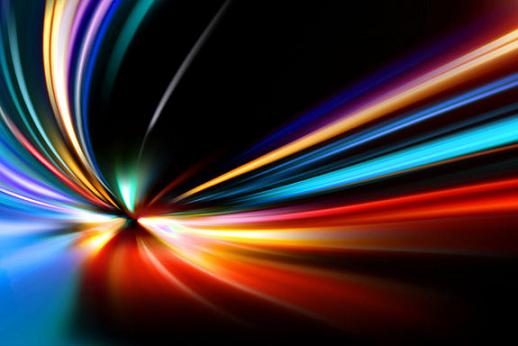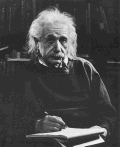|
براساس گزارش لايوساينس، سرعت نور
سرعتي ثابت است، دست كم در تمامي كتابها و متون علمي اينگونه
نوشته شدهاست. اما تعدادي از دانشمندان درحال بررسي اين احتمال
هستند كه اين ثابت، قابل تغيير است و اين تغيير تحت تاثير طبيعت
خلاء در فضا رخ ميدهد.
مفهوم سرعت نور، كه شتابي ثابت را طي زمان براي نور در نظر
ميگيرد، در زمينههاي مختلفي از قبيل كيهانشناسي و نجوم مفاهيم
گستردهتري دارد. براي مثال درزمان محاسبه ثابت ريزساختار يا همان
آلفا، كه قدرت نيروي الكترومغناطيسي را تعريف ميكند، سرعت نور
افزايش پيدا ميكند. نوسان سرعت نور ميتواند قدرت پيوندهاي
مولكولي را تغيير دهد.

Einstein's theory of special
relativity sets of the speed of light, 186,000 miles per second
(300 million meters per second). But some scientists are
exploring the possibility that this cosmic speed limit change
سرعت نور ناثابت ميتواند به اين
معني باشد كه تخمينهايي كه از ابعاد جهان برآورد شده، نادرست
هستند و البته نميتواند به اين معني باشد كه انسان قادر است با
سرعتي بالاتر از نور سفر كند. دو مقاله جديدي كه در مجله European
Physics منتشر شدهاند، تلاش دارند از ويژگيهاي كوانتومي فضا به
سرعت نور برسند. در اين دو مقاله تكنيكهاي متفاوتي براي محاسبه
سرعت نور استفاده شده، اما ايده اصلي آنها احتمال تغيير كردن سرعت
نور تحت تاثير نحوه تعامل ذرات بنيادين با تشعشعات كيهاني است. در
اين مقالهها فضا، خالي درنظر گرفته نشدهاست،بلكه مملو از تركيبي
از ذرات مجازي درنظر گرفته شده كه در كسري از ثانيه بهوجود آمده و
نابود ميشوند.
در مقاله اول كه توسط محققان دانشگاه پاريس ارائه شده، اين ذرات
بنيادين مجازي ذراتي مانند كواركها درنظر گرفته شدهاند،ذراتي
كه همواره با نسخه ضدمادهاي خود جفت ميشوند و در نتيجه به سرعت
ايجاد شده و پس از برخورد با ضدماده خود نابود ميشوند. به گفته
محققان فوتونهاي نوري توسط اين ذرات جذب شده و بازتابيده ميشوند
كه انرژي اين ذرات و بار الكتريكي آنها ميتواند برروي سرعت نور
اثرگذار باشد، حتي اگر اين اثر كمتر از 0.05 فمتوثانيه باشد،
فمتوثانيه برابر يك ميليونيوم از يك ميلياردوم ثانيه است.
در مقاله دوم كه توسط موسسه ماكسپلانك ارائه شده،تعداد ذرات
مجازي بنيادين عامل تغيير در سرعت نور اعلام شدهاند. در اين
مطالعه تعداد اين ذرات كه از بار الكتريكي نيز برخوردارند 100 گونه
اعلام شدهاست، درحالي كه در مدل استاندارد اين ذرات 9 گونه
شناسايي شدهاند. بار اين ذرات متناسب با ميزان بار، منجر به ايجاد
مقاومت امپدانس، نوعي مقاومت در برابر جريان الكتريكي، ميشود.
مقاومت امپدانس نيز خود به ميزان گذردهي خلاء يا ميزان مقاومت
خلاء در برابر ميدانهاي الكتريكي و ميزان نفوذ ميدانهاي مغناطيسي
در آن بستگي دارد. از آنجايي كه امواج نوري تركيبي از امواج
الكتريكي و مغناطيسي هستند،تغيير در ميزان اين امواج ميتواند
سرعت نور را دچار نوسان كند.
برخي از دانشمندان تكنيكهاي محاسباتي استفادهشده در اين دو مقاله
را زير سوال بردهاند و براين باورند از تكنيكهاي نامتناسبي براي
انجام محاسبات در اين دو مقاله استفادهشده است. همجنين تعداد ذرات
بنيادين مجازي كه در مقاله دوم از آنها ياد شده، توسط برخي از
دانشمندان مورد انتقاد قرار گرفتهاست.
نقل از اخبار
علمی روز دنیا
نظریه سی. پی.
اچ.
سال ها قبل از انتار
این مقالات، نظریه سی. پی. اچ. نشان داد که سرعت نور نه تنها تابع
محیط محیط انتشار است، بلکه تابع نیروهای موجود در فضا از جمله
گرانش که در خلاء موجود است نیز می باشد. در نظریه سی. پی. اچ.
گرانش (گراویتون ها) یک موجود کوانتومی نیست، بلکه ذره ای زیر
کوانتومی است و تولید کننده کوانتوم های نور می باشد.
برای مطالعه بیشتر اینجا را
کلیک کنید.
مرز
بین ایمان و تجربه
نامه سرگشاده به
حضرت آیت الله هاشمی رفسنجانی
Speed of Light May Not Be Constant, Physicists
Say
Jesse Emspak, LiveScience Contributor
April 27, 2013
The speed of light is constant,
or so textbooks say. But some scientists are exploring the
possibility that this cosmic speed limit changes, a consequence
of the nature of the vacuum of space.
The definition of the
speed of light has
some broader implications for fields such as cosmology and
astronomy, which assume a stable velocity for light over time.
For instance, the speed of light comes up when measuring the fine
structure constant (alpha),
which defines the strength of the electromagnetic force. And a
varying light speed would change the strengths of molecular
bonds and the density of nuclear matter itself.
A non-constant speed of light
could mean that estimates of the size
of the universe might
be off. (Unfortunately, it won't necessarily mean we can travel faster
than light, because
the effects of physics theories such as relativity are a consequence of
light's velocity). [10
Implications of Faster-Than-Light Travel]
Two papers, published in the European Physics
Journal D in March, attempt to derive the speed of light from
the quantum properties of space itself. Both propose somewhat
different mechanisms, but the idea is that the speed of light
might change as one alters assumptions about how elementary
particles interact with radiation. Both treat space as something
that isn't empty, but a great big soup of virtual particles that
wink in and out of existence in tiny fractions of a second.
Cosmic vacuum and light speed
The first, by lead author Marcel Urban of the
Universitie du Paris-Sud, looks at the
cosmic vacuum, which is often assumed to be empty space. The
laws of quantum physics, which govern subatomic particles and
all things very small, say that the vacuum of space is actually
full of fundamental particles like quarks, called "virtual"
particles. These matter particles, which are always paired up
with their appropriate antiparticle counterpart, pop into
existence and almost immediately collide. When matter
and antimatter particles touch,
they annihilate each other.
Photons of light, as they fly through space, are
captured and re-emitted by these virtual particles. Urban and
his colleagues propose that the energies of these particles �
specifically the amount of charge they carry � affect the speed
of light. Since the amount of energy a particle will have at the
time a photon hits it will be essentially random, the effect on
how fast photons move should vary too.
As such, the amount of time the light takes to
cross a given distance should vary as the square root of that
distance, though the effect would be very tiny � on the order of
0.05 femtoseconds for every square meter of vacuum. A
femtosecond is a millionth of a billionth of a second. (The
speed of light has been measured over the last century to high
precision, on the order of parts per billion, so it is pretty
clear that the effect has to be small.)
To find this tiny fluctuation, the researchers
say, one could measure how light disperses at long distances.
Some astronomical phenomena, such as gamma-ray
bursts, produce pulses of radiation from far enough away
that the fluctuations could be detected. The authors also
propose using lasers bounced between mirrors placed about 100
yards apart, with a light beam bouncing between them multiple
times, to seek those small changes.
Particle species and light speed
The second paper proposes a different mechanism
but comes to the same conclusion that light speed changes. In
that case, Gerd Leuchs and Luis S�nchez-Soto, from the Max
Planck Institute for the Physics of Light in Erlangen, Germany,
say that the number of species of elementary particle that exist
in the universe may be what makes the speed of light what it is.
Leuchs and Sanchez-Soto say that there should be,
by their calculations, on the order of 100 "species" of particle
that have charges. The current law governing particle physics,
the Standard Model, identifies nine: the electron, muon, tauon,
the six
kinds of quark, photons and the W-boson. [Wacky
Physics: The Coolest Little Particles in Nature]
The charges of all these particles are important
to their model, because all of them have charges. A quantity
called impedance depends on the sum of those charges. The
impedance in turn depends on the permittivity of the vacuum, or
how much it resists electric fields, as well as its
permeability, or how well it supports magnetic fields. Light
waves are made up of both an electric and magnetic wave, so
changing those quantities (permittivity and permeability) will
change the measured speed of light.
"We have calculated the permittivity and
permeability of the vacuum as caused by those ephemeral virtual
unstable elementary particles," Soto-Sanchez wrote in an email
to LiveScience. "It turns out, however, from such a simple model
one can discern that those constants contain essentially equal
contributions of the different types of electrically charged
particle-antiparticle pairs: both, the ones known and those so
far unknown to us."
Both papers say that light interacts with virtual
particle-antiparticle pairs. In Leuchs' and Sanchez-Soto's
model, the impedance of the vacuum (which would speed up or slow
down the speed of light) depends on the density of the
particles. The impedance relates to the ratio of electric fields
to magnetic fields in light; every light wave is made up of both
kinds of field, and its measured value, along with the
permittivity of space to magnetic fields, governs the speed of
light.
Some scientists are a bit skeptical, though. Jay
Wacker, a particle physicist at the SLAC National Accelerator
Laboratory, said he wasn't confident about the mathematical
techniques used, and that it seemed in both cases the scientists
weren't applying the mathematical tools in the way that most
would. "The proper way to do this is with the Feynman diagrams,"
Wacker said. "It's a very interesting question [the speed of
light]," he added, but the methods used in these papers are
probably not sufficient to investigate it.
The other issue is that if there really are a lot
of other particles beyond what's in the Standard Model, then
this theory needs some serious revision. But so far its
predictions have been borne out, notably with the discovery
of the Higgs boson. This doesn't mean there aren't any more
particles to be found � but if they are out there they're above
the energies currently achievable with particle accelerators,
and therefore pretty heavy, and it's possible that their effects
would have shown up elsewhere.
Follow us @livescience, Facebook & Google+.
Original article onLiveScience.com.
Source: LiveSience
امید عمومی - نامه
به ریاست جمهوری
مرز بین ایمان و تجربه
نامه
سرگشاده به حضرت آیت الله هاشمی رفسنجانی
آخرین
مقالات
1 2 3 4 5 6 7 8 9 10 11 12 13 14 15 16 17 18 19 20 21 22 23 24 25
26 27 28 29 30 31 32 33 34 35 36 37 38 39 40
|


